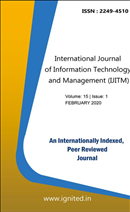A Study of HRM in Team Building and Organizational Development
Main Article Content
Authors
Abstract
The goal of teambuilding activities is to increase productivity by strengthening relationshipsamongst employees. The potential for dissatisfaction among team members should be taken into accountthroughout the hiring process. Team building activities should be supplemented by actual work experience.Good HR policies and procedures may aid in the formation of effective teams, which may increase outputand morale. Individual members, supervisors, and upper-level executives, as well as the organization'soverall structure, culture, work methods, and social interactions, are all affected. The new rules areexpensive and complicated, so it will take time to form an effective implementation team and put them intoeffect. The gains have been so considerable, however, that those responsible for their implementationhave no intention of going back to the previous systems. Despite these obstacles, a concerted effort todevelop teams may lead to a number of beneficial outcomes. That's why we're looking at how tomaximize team productivity.
Downloads
Download data is not yet available.
Article Details
Section
Articles
References
- Ali, R., & Ahmed, M. S. (2009). The impact of reward and recognition programs on employee‟s motivation and satisfaction: an empirical study. International Review of Business Research Papers, 5(4), 270- 279.
- Allen, N.J., & Meyer, J.P. (1996). Affective, continuance and normative commitment to the organization: an examination of construct validity. Journal of Vocational Behaviour, 49, 252-276.
- Andrew, D. P. S., & Kent, A. (2007). The impact of perceived leadership behaviours on satisfaction, commitment, and motivation: An expansion of the multidimensional model of leadership. International Journal of Coaching Science, 1(1), 35-56.
- Dave Ulrich, “HR at a Crossroads “, People Matters, June 2015.
- Dave Ulrich, “Securing the future of HR by adding value,” People Matters, November 2011.
- Michie, J., & M. Sheehan. 2005. “Business Strategy, Human Resources, Labor Market Flexibility and Competitive Advantage,” International Journal of Human Resource Management 16(3), 445-464.
- Ab. Aziz Yusof. (2003). Gelagat organisasi: Teori, isu dan aplikasi (1st ed.). Kuala Lumpur: Prentice Hall/Pearson Malaysia Sdn Bhd.
- Argote, L. & McGrath, J.D. 1993, ‘Group Processes in Organizations: Continuity and Change’, International Review of Industrial and Organizational Psychology, vol. 8, C.L. Cooper & I.T. Robertson (eds), John Wiley &Sons, New York.
- Blundel, R. (2004). Effective organizational communication: Perspectives, principles, and practices (2nd ed.). Harlow: FT Prentice Hall.
- Brower, M.J. 1995, ‘Empowering Teams: What, Why and How’, Empowerment in Organizations, vol. 3, no. 1, pp. 13- 25.
- Christopher, H. (1935). Philosophy of Leadership.
- Davis, K. C. (1980). Human Behavior at Work Organization New York, Macgrauhill Publication Company.

